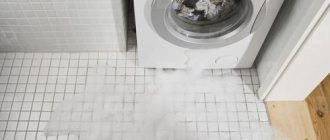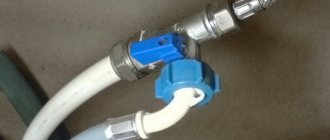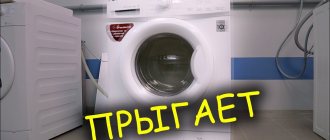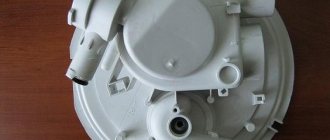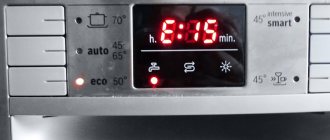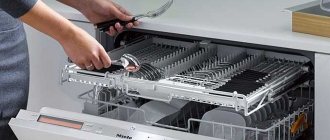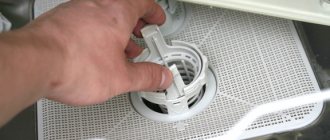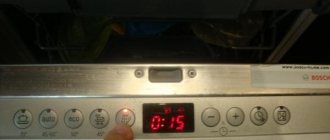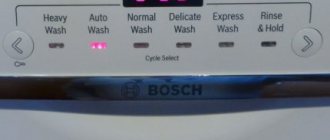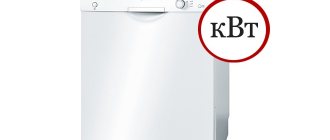Checking the correct use of the dishwasher
Often the cause of many malfunctions is failure to follow the manufacturer's instructions for operating the equipment. It is important to check that the dishwasher is being used correctly. First of all, you should make sure that there is water flowing into the tap. In apartments, water is supplied to the kitchen by one riser. If there is no water coming into the faucet, the dishwasher will not get any water either. Interruptions in the water supply often lead to temporary problems with the dishwasher.
It is important to use a suitable and high-quality detergent. The use of low-quality household chemicals can lead to serious malfunctions of the dishwasher. Usually the manufacturer gives recommendations regarding the choice of detergents.
The water supply valve may be closed. The mechanism is located at the point where the device hose connects to the water supply system. When the tap is closed, the equipment cannot draw water, so it must be opened.
Constant supply and drainage of water by the dishwasher: solution to the problem
Constant collection and drainage of the PMM is one of the most common breakdowns.
Possible reasons may be:
- leak;
- failure of the pressure sensor (pressostat);
- intake valve malfunction;
- control board malfunction.
The breakdown itself is accompanied by constant intake and drainage, the appearance of one or another error code on the indicator, constant noise of the liquid being drawn in and the hum of the drainage pump.
The problem is solved by replacing a failed device module
Advice. To avoid system failure when loading and draining, you should unplug the dishwasher, let it rest for a short time and start it again. The absence of a positive effect will indicate a serious breakdown.
What to check first
The reasons why water does not flow into the machine are the same for dishwashers from Beko, Bosch, Ariston and others. The most modern models of dishwashers include the Aquastop system; sometimes it is this system that fails, but there are other problem areas.
Tap water
The first thing they do is go to the sink if the dishwasher hums when turned on, but does not fill with water. Open the tap. The sound of hissing and lack of water explain the cause of the malfunction. The device is working properly, there are problems with the water supply.
The door is not closed tightly
This is the most common reason. Many housewives are in a hurry and do not close the door all the way. In this case, the blocking is triggered. The indicators on the control panel are on, but the unit is silent. Water does not fill, the pump does not make noise. The problem can be easily solved. The door is opened and closed again until it clicks.
Water supply valve
When leaving the house (apartment) for a long period of time, the owners turn off the valve that connects the dishwasher hose to the water supply system. Upon returning, they forget to open it, turn on the device, and feel frightened.
If water does not flow into the machine, check the valve first.
Hose
Tap water can get scale and other debris into the device. It can damage the machine. To prevent this from happening, a mesh filter is installed at the point where the hose connects to the water supply network. When the mesh on the filter becomes clogged, water flows poorly into the tank, the dishwasher hums, but does not work.
This malfunction can be easily eliminated:
- unscrew the hose;
- remove the strainer;
- large particles are removed from it;
- the holes are cleaned with a needle;
- the plaque is cleaned off with a solution of citric acid, the strainer-filter is lowered into it for 1-1.5 hours.
Home dishwasher does not fill with water: causes of breakdowns and malfunctions
Currently, household appliances from various manufacturers are used - Ariston, Bosch, Beko, Siemens, Aeg. They differ from each other in technical parameters - dimensions, capacity, power, energy consumption and various operating modes. Despite this, the principles of operation are generally approximately the same, so we can consider the same reasons why water does not flow into the machine.
The most common reasons for dishwasher failure are:
- faulty or incorrect connection of the inlet filter;
- clogged internal water filters;
- door malfunction;
- incorrect operation of the water level sensor (pressostat);
- control system malfunctions.
The brand of the dishwasher, as already mentioned, does not play a special role. The causes of breakdowns are usually approximately the same, so you can consider the same days and options, as well as repair methods.
However, some models of cars, usually more modern ones, are equipped with the AquaStop system. It represents a leakage protection system. The hose through which water flows is covered with a protective casing. In the event of an emergency, the system can shut off the water supply. In some cases, a malfunction of the AquaStop system prevents water from being drawn into the dishwasher. This option also cannot be discounted.
See also -
Tablets do not dissolve in the dishwasher - what should I do?
Fill valve broken
The reasons why water cannot get into the dishwasher may be related to the operation of the fill valve. This valve is a rather sensitive element of the dishwasher and even a pressure drop can damage it. In particular, manufacturers of Bosch dishwashers in the instructions for their products indicate recommendations for installing a dishwasher if the pressure in the water supply is above 1 MPa. In addition to flow-through cleaning filters, they recommend installing pressure reducing valves.
If there is no pressure relief valve, and the water pressure is significant, then the dishwasher’s own fill valve will quickly break and either will not open at the right time, or, on the contrary, will remain open and water will constantly flow into the machine. In this case, it is almost impossible to repair the valve, because the mechanism breaks down and will have to be replaced. If the valve is simply clogged with dirt and does not open, then the problem can be solved by ordinary mechanical cleaning.
The water level sensor is to blame
The Bosch dishwasher seems to be humming and the lights are still on, but why doesn’t the water pour in? The culprit of this disgrace may be the pressure switch of the dishwasher. This device, also called a water level sensor, is required to accurately determine how much water is in the car at a given time. But the problem is that at one not very wonderful moment he may refuse to perform his function and then the following will happen:
- water will actually flow into the dishwasher, but the control module will not know about it;
- the machine will overflow and the pump will begin to pump out excess water in emergency mode;
- the control module, thinking that water is not flowing into the machine, generates a system error and stops the program.
It is not difficult to understand that this is exactly what happened to your dishwasher. Listen to whether there is water in the dishwasher, whether the pump is working, pumping out water, and whether the water is babbling in the drain hose and pipe. If all this takes place, then the first version that will need to be checked is a breakdown of the pressure switch. You can read about how to check and replace the pressure switch in the corresponding article published on our website.
Breakdown of the pressure switch
Sometimes trouble occurs due to a malfunction of the water level sensor. This element sends signals to the control board that the water in the dishwasher has reached a predetermined level. If the pressure switch is faulty, the microcontroller does not receive signals, and therefore no water flows.
Instructions for replacing the water level sensor:
- Unplug the plug and remove the sensor from the dishwasher body. When penetrating the internal structure of the product, remember safety. Some dishwasher models have a capacitor in their design. It retains its charge for a long time, even if the equipment has been unplugged. Therefore, before opening the cover of the device, unplug the product from the outlet and wait at least 15 minutes so that the condenser is discharged and there is no risk of electric shock.
- For convenience, mark the electrical connections of the pressure switch and remove the ends from the wires of the sensor terminals using pliers.
- Remove the plastic tube from the spigot and gently blow into the tube. This is necessary to check the operation of the node. If the sensor is working properly, you will hear a typical click. To avoid damaging the internal mechanism of the sensor, do not blow too hard into the tube.
- If during the inspection it was determined that the sensor is broken, purchase a similar spare part and install it. Replace the tube and connections. Check that everything is installed as it was before.
If water does not flow into the dishwasher, you need to adjust the water supply level and send a signal to the board that produces the machine's pressure switch. This part is equipped with a liquid volume level sensor in the chamber. Due to its multi-functionality, the washing program requires different volumes of liquid. A pressure switch is provided for the automated washing program and to control the filling of the required amount of water into the chamber.
When does the dishwasher not fill with water?
Sometimes situations arise when the dishwasher cannot draw the required amount of water within a certain period of time set by the manufacturer (for example, 10 minutes). In such cases, the PMM stops working, sometimes buzzes, and the display shows an alphanumeric error code. For example, dishwashers from Bosch and Siemens signal a similar emergency situation with codes E3, E8 or E15.
Error codes E3 and E8 appear when the PMM does not take in water
Liquid may not flow into the dishwasher tank for reasons that are easy to find out and fix yourself:
- There is no water in the water supply or its pressure is very low. This is easy to determine - turn on the faucet in the bathroom or kitchen.
- The water stop valve located at the entrance to the apartment or at the outlet of the tee through which liquid is supplied to the dishwasher is closed.
- Careless handling of the door resulted in the blocking sensor not working. In this case, the liquid will not flow into the PMM until the door is tightly closed.
- The inlet hose through which water enters the dishwasher is pinched. This may happen due to rearrangement of furniture or other reasons. Checking and restoring its patency is quite simple.
If you pull the inlet hose, it will bend and will not allow water to pass through.
In the above situations, restoring the water supply and the functionality of the PMM is quite simple, and anyone can do it. But there are more complex problems, the elimination of which requires certain knowledge and skills:
- The flow or inlet coarse filter is clogged. Typically, the inlet filter element is located where the inlet hose connects to the dishwasher body.
- The Aquastop protective module, which shuts off the water supply if there is a liquid leak in the dishwasher, has worked or failed (error code in the Bosch, Siemens PMM - E15).
- The device that locks the front door of the dishwasher has stopped working. In this case, the electronic control unit (hereinafter also referred to as the ECU) does not receive a signal to close the door and stops working.
- The inlet valve does not open (failure may be caused by a blockage or water hammer in the water supply system). There may be a missing control signal from the ECU.
- The water level sensor in the PMM tank (hereinafter also referred to as the pressure switch) is faulty. It may send an erroneous signal to the ECU that fluid has already been filled.
- The electronic control unit of the dishwasher has failed and does not provide a control signal to open the inlet valve.
Why does the dishwasher not fill with water?
In each PMM model, a certain time is programmed so that the required amount of water for washing dishes enters the tank. Typically this time period is from 10 to 15 minutes. If the water level sensor (pressostat) does not inform the control unit within the set time that the required volume of liquid has been reached, the machine stops executing the work program.
Error E8 in a Bosch dishwasher, indicating that water has not filled within the allotted period of time
i 10 or iF 0 appear on the displays of Electrolux and Zanussi dishwashers . When the iF0 code appears, the machine tries to continue working, the circulation pump hums, but nothing happens. By the way, in this case the electric heater (TEH) may burn out, so the device should be turned off and de-energized. German dishwashers Bosch and Siemens report defects with error codes E 3 or E8.
The reasons for the lack of the required amount of water, which can be eliminated independently, are as follows:
- There is no water supplied to the water supply or its pressure is very weak. To check, just open any tap.
- The PMM door is not fully closed, that is, the lock is not latched. If this is the case, the control module will not receive a signal to block the door and the work program, which includes the water collection stage, will simply not start. Close the door again until it clicks.
- One of the shut-off ball valves is closed (the first is usually located at the entrance of the water supply to the apartment, and the second is in front of the inlet hose of the dishwasher). They need to be checked.
- The inlet hose is pinched, kinked or kinked. This situation rarely arises, unless you previously rearranged, repaired, or tinkered with the plumbing or dishwasher in the kitchen. Check the condition of the inlet hose.
This is what a closed valve in front of the dishwasher inlet hose might look like.
As you can see, in the above situations, any person, even a completely unprepared one, can cope with diagnosing and eliminating problems. But there are situations that require minor or more complex repairs. These include the following possible damages:
- A blockage has formed in the inlet strainer, making it difficult to supply water from the water supply. Usually, pieces of rust and other debris get into the mesh, which spreads along with the tap liquid.
- A leak occurred and water got into the pan, which triggered the Aquastop system and caused an error code to appear. The solenoid valve of this system, built into the inlet hose, may have failed and cut off the water supply. There is also a possibility of a system sensor failure
- The latch in the PMM door does not work and does not send a signal to the control module that the door is locked and work can begin.
- The intake valve, triggered by signals from the electronic control unit (ECU), has failed or there is damage to the ECU, although this probability is low. The contact in the cable connections of the parts may be broken.
- The pressure switch is faulty, supplying the control unit with incorrect information about the amount of water collected. If it informs you that the water tank is full, although it is not, liquid will not be collected. Sometimes the opposite happens - the ECU receives information that there is not enough water, although the tank is already full. This ends with overflow, leakage into the pan and activation of the Aquastop system.
Code combination E15 in a Siemens dishwasher, indicating a leak and activation of the Aquastop system
If every owner can remove and check the filler filter for blockages, then testing the Aquastop system sensor, inlet valves, door latch and the condition of the cable wiring will be more difficult. To do this, in addition to a set of tools for disassembling the case, you must have a multimeter.
A standard set of tools, a soldering iron and a multimeter is usually sufficient to troubleshoot most dishwasher problems.
Diagnosis of the causes and troubleshooting of the dishwasher
The most common reasons why your dishwasher won't fill with water include:
- the door is not tightly closed because the door lock is broken;
- the filter is clogged;
- the Aquastop system has blocked the fluid supply;
- the temperature sensor has broken or the heating element has burned out;
- problems with the control module;
- the filling valve has failed;
- The water level sensor is broken.
Some of the reasons can be eliminated yourself, for example, by cleaning the filters. More complex breakdowns require certain knowledge and special tools.
Advice. If your dishwasher is under warranty, contact a professional immediately.
The door is not closed tightly
The device door has a lock that protects it from leaks. When it is closed, the control module receives a signal that the door is locked, and the machine starts working. If the lock is broken, the door does not close until it clicks. There is no blocking signal, the program does not start and liquid is not collected.
If the lock breaks, you can change it yourself. How to do it:
- the dishwasher is disconnected from the power supply;
- unscrew the front panel;
- unscrew the broken door lock;
- install a new latch;
- screw the panel.
Filter clogged
An inlet valve filter is installed to protect equipment from dirt and debris that comes from the water supply. It is periodically cleaned or replaced. If liquid is drawn into the dishwasher too slowly or does not flow at all, then the reason is most often a clogged filter. They clean it on their own or call a professional.
Before cleaning, turn off the water supply. Unscrew the hose and remove the filter. It is located at the inlet of the intake valve. The mesh is washed under running water. If it is heavily soiled, clean it with a needle or dip it in a solution of citric acid (30 g per 1 l) for an hour. Then the cleaned filter is installed again and the hose is connected.
Aquastop worked
Dishwashers are equipped with a leakage protection system - Aquastop. Reasons why equipment stops working:
- the solenoid valve blocked the water supply due to a leak;
- the system itself failed.
The most common reasons why the dishwasher does not fill with water
Considering the “purity” and “softness” of city water, one of the common malfunctions of dishwashers is a clogged inlet valve filter (in this case, water is drawn in very slowly or not at all). A special mesh filter protects the machine from various types of impurities and abrasive substances found in our water. You can fix this breakdown yourself, but this will require a little skill. Try unscrewing the water supply hose after shutting off the water. Where the hose connects to the machine, find the mesh filter that is located “at the inlet” of the inlet valve directly on the dishwasher. Clean the mesh with a needle or by immersing it in a citric acid solution for 30 - 60 minutes.
If cleaning the filter does not make the dishwasher work normally, then something more serious has happened to it. Let's figure it out together!
| Breaking | Cause of failure |
| Door lock malfunction | The dishwasher door is equipped with a locking device. It is necessary for user safety and protection against leaks. If this device fails, the machine does not start the washing cycle and, accordingly, does not draw water. The dishwasher door lock needs to be replaced. |
| The inlet valve is faulty | All dishwashers are equipped with a water inlet valve. When the equipment starts working, a signal is sent to the valve, which in turn opens and water begins to pour into the machine. Due to voltage fluctuations or wear, the valve may “burn out”. The water supply valve needs to be replaced. |
| There is a malfunction in the water level sensor (pressostat) | A pressure switch is a special sensor that measures water pressure and transmits information to the control module, which, in turn, analyzes how much water is needed for each washing cycle. If the pressure switch fails, the control module does not receive a signal and the dishwasher does not draw water. The water pressure sensor needs to be replaced. |
| The control module has failed | Dishwashers are equipped with an “intelligent” control module that issues software commands to other components of the unit, for example, “add water” to the inlet valve or “drain water” to the drain pump. If a malfunction occurs in this device, the machine stops working or does so incorrectly. The module needs to be re-flashed or completely replaced. |
| The Aquastop system is faulty (only in dishwashers equipped with Aquastop) | Modern units are equipped with the Aquastop leak protection system (AQUASTOP). If a “dishwasher” with this technology suddenly stops working, there can be two problems: either a leak occurred and Aquastop blocked the water supply, or the system itself failed. If there is a malfunction in the Akvpastop, the system needs to be repaired or completely replaced. |
Even though most breakdowns in dishwashers are quite typical, sometimes malfunctions occur that are difficult to diagnose based on any additional signs. Considering the manufacturability of modern technology, it is not recommended to try to fix the dishwasher yourself - doing it on your own is unlikely to give a positive result, but it can easily send your “helper” to the trash heap. The most reasonable way out in this situation is to entrust the repair work to professionals.
Decoding errors
All dishwasher models have a self-diagnosis program. It protects the device from serious damage. In critical situations, an error code appears on the electronic display; the meaning of each is given in the operating instructions.
In any models, errors are grouped into categories:
- malfunctions of drainage and water supply;
- deviations in the water heating process;
- malfunctions of water sensors and switches;
- electrical problems.
The instructions for each error code contain a description of the probable malfunction and how to eliminate it. In the table of malfunctions of BOSCH models.
| Code | Decoding |
| E27/F27 | There was a power surge |
| E22/F22 | The filter is clogged |
| E01/F01 | Problems with the electronic unit |
| E3/F3 | No water coming in |
| E15/F15 | The leakage protection system has activated |
| E09/F09 | The heating element does not work |
| E24/F24 | Waste fluid does not drain |
| E25/F25 |
Causes of breakdowns
Most often, those components and elements of the dishwasher that fail are those that are subjected to mechanical stress during operation, have a complex design, or are in contact with poor-quality water. The causes of breakdowns are also associated with the listed factors.
Filter clogged
Tap water in our country is rarely absolutely pure. Various impurities, sand, rust and other debris are regularly supplied to our houses and apartments along with water.
These contaminants can damage the PMM, so all manufacturers proactively provide protection for their products from dirt. It is performed in the form of an input filter. Its mesh traps all the debris, but after some time it can become completely clogged and block the flow. Quite often, a hum is heard and the washing does not start.
In dishwashers, it is located on the inlet hose, at the point of connection to the body. Accordingly, you need to unscrew it, having first shut off the water supply to the riser.
External water supply problems
Problems arise not only due to a broken dishwasher, but also due to interruptions in the water supply. There may be no water supply either in the water supply itself or in the inlet hose.
A closed tap will also prevent you from using an automatic wash.
Aquastop failure
Violation of the tightness between the dishwasher components leads to the appearance of water in the pan. There is a leakage sensor there. If it works and gives a signal, the control system will automatically stop filling with water.
Sometimes false alarms occur when the sensor itself fails.
Problems with the door
The dishwasher door has a complex design and problems with it are not uncommon. There may be several reasons for this to not work:
- The locking mechanism is malfunctioning and the door cannot close completely. Because of this, the sensor does not work and the device does not start;
- the door lock is broken;
- The closing sensor does not work.
Sometimes all of the above happen at the same time.
Failure of the pressure switch
The volume of water poured into the dishwasher is monitored by a special device - a pressure switch. It is through it that the control board gives commands to start and stop water supply. If it does not work correctly, then it is possible that either the tank overflows and the “aquastop” is triggered, or the flow of water does not begin at all.
Reasons why there is no water supply in the dishwasher
Most often, those components and elements of the dishwasher that fail are those that are subjected to mechanical stress during operation, have a complex design, or are in contact with poor-quality water. The causes of breakdowns are also associated with the listed factors.
Filter clogged
Tap water in our country is rarely absolutely pure. Various impurities, sand, rust and other debris are regularly supplied to our houses and apartments along with water.
These contaminants can damage the PMM, so all manufacturers proactively provide protection for their products from dirt. It is performed in the form of an input filter.
Its mesh traps all the debris, but after some time it can become completely clogged and block the flow. Quite often, a hum is heard and the washing does not start.
In dishwashers, it is located on the inlet hose, at the point of connection to the body. Accordingly, you need to unscrew it, having first shut off the water supply to the riser.
Filter on the water inlet hose
External water supply problems
Problems arise not only due to a broken dishwasher, but also due to interruptions in the water supply. There may be no water supply either in the water supply itself or in the inlet hose.
A closed tap will also prevent you from using an automatic wash.
Aquastop failure
Violation of the tightness between the dishwasher components leads to the appearance of water in the pan. There is a leakage sensor there. If it works and gives a signal, the control system will automatically stop filling with water.
Sometimes false alarms occur when the sensor itself fails.
Aquastop sensor in the dishwasher tray
Problems with the door
The dishwasher door has a complex design and problems with it are not uncommon. There may be several reasons for this to not work:
- The locking mechanism is malfunctioning and the door cannot close completely. Because of this, the sensor does not work and the device does not start;
- the door lock is broken;
- The closing sensor does not work.
Sometimes all of the above happen at the same time.
PMM door
Failure of the pressure switch
The volume of water poured into the dishwasher is monitored by a special device - a pressure switch. It is through it that the control board gives commands to start and stop water supply. If it does not work correctly, then it is possible that either the tank overflows and the “aquastop” is triggered, or the flow of water does not begin at all.
The cause of the malfunction may be mechanical damage or clogging of the pressure switch.
Is a dishwasher profitable?
Oh yes! No
Control module failure
The control board is a complex electronic device consisting of several relays and many radio components. If at least one element fails, the dishwasher may not turn on at all, or may begin to work incorrectly, even to the point where water supply fails.
Due to the complexity of this node, it is better to entrust the diagnosis to a specialist. To correctly determine the cause of a breakdown, you will need not only special equipment, but also experience in performing such work.
PMM module
Troubleshooting problems with water supply to the PMM
If you have already checked everything that is possible, but water still does not flow into the system, then you need to inspect individual parts. Start by cleaning the filter and hose:
- close the shut-off valve;
- unscrew the inlet hose;
- behind it there is a filter mesh;
- rinse the parts under pressure from the tap; you can use a small brush to clean the hose.
At the same time, you can check the remaining details.
Fill valve
If water is not supplied to the Bosch dishwasher, the intake valve is inspected first. Visually check for mechanical damage on the surface of the part. To test the electronics, you need to apply voltage to the element, which will show whether the membrane opens or not.
The electrical part is tested with a multimeter, the resistance is measured and a verdict is made.
The intake valve cannot be repaired. You will need a complete replacement of the element, which you can do yourself. Disconnect the wiring and unscrew the screw securing the part. The main thing is to select an original spare part for the make and number of your car.
Hopper door
Until the chamber door is tightly closed, the machine will not start working. What if the door does not close all the way? Check:
- Seal. When it becomes deformed or comes out of its seat, it can interfere with normal closure.
- Latch. A broken lock will not make the door “click” and the system will not start.
- Placement of baskets and other camera elements. There may be something preventing the door from closing.
- Installation of PMM. Check the placement of the machine using a building level.
How to install a new door lock:
- open the bunker door;
- Unscrew the bolts around the perimeter of the inner part;
- remove the outer panel;
- disconnect the wiring;
- Unscrew the fastening screws and remove the lock;
- install the new element and connect the wiring.
- reassemble in reverse order.
We do not recommend replacing individual broken parts when trying to repair an old lock. This does not guarantee long-term use.
"Aquastop" system
First of all, check if there is any water in the pan. When a leak occurs, the protection float floats up, presses on the switch, and the water intake is blocked. When “Aquastop” is activated in the dishwasher, fault code E15 may appear on the display.
What to do:
- unscrew the hose from the body (if you have a mechanical Aquastop);
- look at the valve inside: if it is pressed tightly against the walls of the hose, then the protection needs to be replaced;
- To do this, disconnect the old hose and install a new one.
If you have an electromagnetic device, then additionally connect the wire to the sensor.
Level sensor
Incorrect pressure switch readings can also cause a lack of water. We wrote how to replace the level sensor in one of the articles. Most often, the device is a plastic box that is attached to the circulation pump. Checking its mechanics is very simple - blow into the pressure tube. If you hear clicks, the pressure switch is working.
The electrician is checked with a multimeter.
Electronic module
Modern Bosch dishwashers are equipped with a control module. He manages all processes in the machine and gives commands to the nodes. For example, drain the water from the bunker or start drawing water. If one of the board's triacs burns out, then some part stops functioning. Therefore, the module requires flashing or replacement.
Only a specialist can diagnose and repair the electronic board.
You can check the parts in your Bosch dishwasher yourself. Sometimes the reasons for the lack of water lie in a small blockage, so before calling a technician, make sure that the breakdown really exists.
Water does not flow into Bosch PMM: reasons
The quality of assembly of equipment by the German corporation Bosch is known throughout Europe and beyond. But even the most reliable household appliances are not immune to failures. Often, the majority of problems are caused by violation of operating rules, incorrect installation, power surges, etc. Therefore, manufacturers have nothing to do with most breakdowns. Analyzing the real reasons why there is no water supply to the Bosch dishwasher, we note the following points:
- There is no water or insufficient pressure in the water pipe.
- The valve is closed, which is why the system does not supply water to the PMM.
- The inlet hose is kinked or pinched.
- The Aquastop system worked, causing the water intake to be blocked.
- A power surge caused the solenoid start valve to fail.
- The hopper door is not closed tightly enough, which is often accompanied by a flashing liquid supply indicator.
- Level sensor failure. In the event of a failure, the sensor transmits incorrect data to the module, which is why water is not poured into the system.
- The filter screen installed on the inlet valve is clogged. The fastest way to solve the problem is to simply remove and wash the filter mesh.
- Failure of an electronic unit is a rare and complex breakdown that practically excludes self-repair.
Important! Do not try to find the cause of the module failure yourself: repairing it is the task of specialists. You will need a special tool and certain skills.
